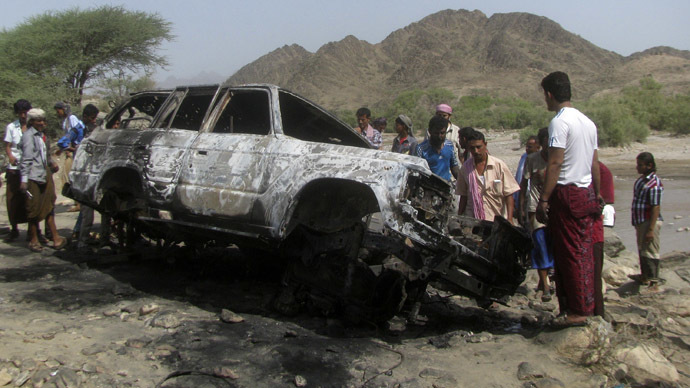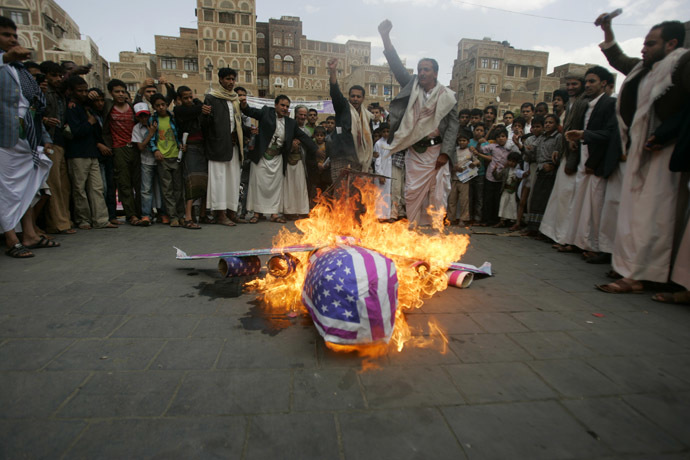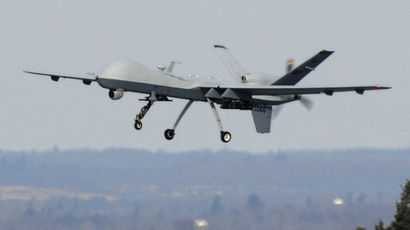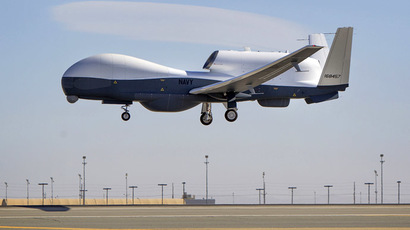American airstrikes in Yemen kill more civilians than terrorists – HRW report

A new report by Human Rights Watch once again confirms that Hellfire rockets lack selectivity and exterminate women and children more often than they hit Al-Qaeda associates. Last month the UN urged the US to reveal data on civilian drone casualties.
The prominent human rights organization has released a detailed 102-page report on the US drone attacks and airstrikes in Yemen against militants of the Al-Qaeda wing in the country simultaneously with another human rights organization Amnesty International issuing a report on US drone strikes in Pakistan.
Basically, the HRW report has maintained an already widely-known fact that civilians die too often in reported ‘surgical’ strikes which is unacceptable even by the ‘law of war’.
“The US has launched about 80 targeted killing operations in Yemen since 2009,” claims Humans Rights Watch Senior Researcher Letta Tayler.
Still, the HRW report considers only six of them, one of which
took place in 2009, and other five occurring in 2012-2013. These
six attacks claimed the lives of 82 people, 57 of whom - or
practically 70 percent - were civilians.
According to one of the two the UN reports on drones issued in September, “the first remotely piloted aircraft strike reported in Yemen occurred on November 3, 2002, in an operation aimed at killing a suspect in the bombing of the USS Cole in February 2000.”
After that there were no drone strikes in Yemen till May 2011, when a failed attempt to kill cleric Anwar Awlaki, a dual Yemeni and American citizen, took place.
Several months later, in September 2011, a drone killed Awlaki anyway, opening the way to dozens of ‘target killings’ done by both military and special services, such as the CIA, drones. The total fatalities in Yemen drone warfare estimated by the UN are “between 268 and 393.”
The deadliest of those airstrikes that came into the HRW’s spotlight was probably not the work of drones at all. It occurred in a village of Al-Majalah on December 17, 2009, where alleged US Navy cruise missiles (too big to be fired from a UAV) dropped cluster bombs on a Bedouin village, killing 14 alleged militants along with 41 civilians, including nine women and 21 children. Only five people survived.
“I have a question for America: Despite having drones and spy planes and all of this technology, can’t America differentiate between a terrorist and an innocent civilian?” told the HRW Moqbil Muhammad Ali, who lost 28 relatives in the attack on Al-Majalah village.
So far American strikes to eliminate militants have practically always been accompanied by civilian casualties, despite President Barack Obama promising to avoid them.
“And before any strike is taken, there must be near certainty that no civilians would be killed or injured, the highest standard we can set,” the HRW quoted President Barack Obama as saying.
“President Obama says the US is doing its utmost to protect civilians from harm in these strikes. Yet in the six cases we examined, at least two were a clear violation of the laws of war,” commented Tayler.
The HRW report also points out that civilian casualties actually work against the US efforts to decrease the terror threat in Yemen.
“Should the United States continue targeted killings in Yemen without addressing the consequences of killing civilians and taking responsibility for unlawful deaths, it risks further angering many Yemenis and handing another recruiting card to AQAP [Al-Qaeda in the Arab Peninsula]. In response to these killings, AQAP has issued statements accusing the United States of fighting a war not just against Al-Qaeda, but against all Muslims. Residents have set up roadblocks and held demonstrations in which they chant anti-US slogans,” the report reads.
Among cases mentioned in the HRW report is an attack that happened on September 2, 2012, when a US strike on a vehicle in a central Yemeni city of Radaa killed 12 civilians, including three children and a pregnant woman, while the intended target, a tribal leader named Abd Raouf Dahab, was nowhere near the vehicle.
Another airstrike took place on January 23, 2013, killing two alleged militants in a Yemeni village of Al-Masnaah, but again with two confirmed civilian victims.
According to the HRW report, civilians who have absolutely no
contacts with terrorists sometimes die trying to earn some money
and giving a lift to strangers who turn out to be militants. In
that case when an airstrike is launched against such vehicles,
missiles destroy the cars with everyone inside.

Also witnesses questioned by the HRW very often mention the fact that victims of airstrikes were not simply mutilated, but also charred beyond recognition, which raises a question about possible thermobaric nature of the warheads used in the US missiles.
One modification of the Hellfire rockets in the US possession, AGM-114N, has a thermobaric warhead.
The Human Rights Watch group does not question America’s right to eliminate its enemies in ‘targeted killing’ strikes without a court ruling, but calls to minimize civilian casualties in the process.
“President Obama should acknowledge these strikes and the US should ensure that it is following the law and President Obama’s policies on targeted killings so that civilians are not unnecessarily killed in these strikes,” Tayler said.
Washington has always insisted that its lethal drone strikes abroad, in countries like Pakistan and Yemen, are fully legitimate, being conducted within the framework of the ‘War on Terror’ against terrorist organizations such as Al-Qaeda and its associates.
In September, British barrister and UN special rapporteur on counter-terrorism Ben Emmerson, the author of second of two latest UN reports on the use of drones, accused the CIA of creating the ‘almost invariably classified’ atmosphere around the special forces drone operations in Yemen.
Drone strikes are being made these days on an ‘accountability vacuum’ condition, Emmerson claimed, demanding a full public investigation into the civilian casualties issue be launched, even if it demands certain “redactions on grounds of national security.”
The CIA’s own estimates of civilian deaths in Yemen due to drone strikes, according to the UN report, confirming no more than 58 civilian casualties at the highest.
Legal Director of the human rights charity Reprieve, representing
civilian victims of drone strikes, Kat Craig, told the Bureau of
Investigative Journalism that the UN report by Ben Emmerson
“highlights the US’ failure to reveal any information
whatsoever about their shadowy, covert drone program. Hiding the
reality of civilian deaths is not only morally abhorrent, but an
affront to the sort of transparency that should be the hallmark
of any democratic government. Some basic accountability is the
very least people in Pakistan and Yemen should expect from the
CIA as it rains down Hellfire missiles on their homes and
villages.”














